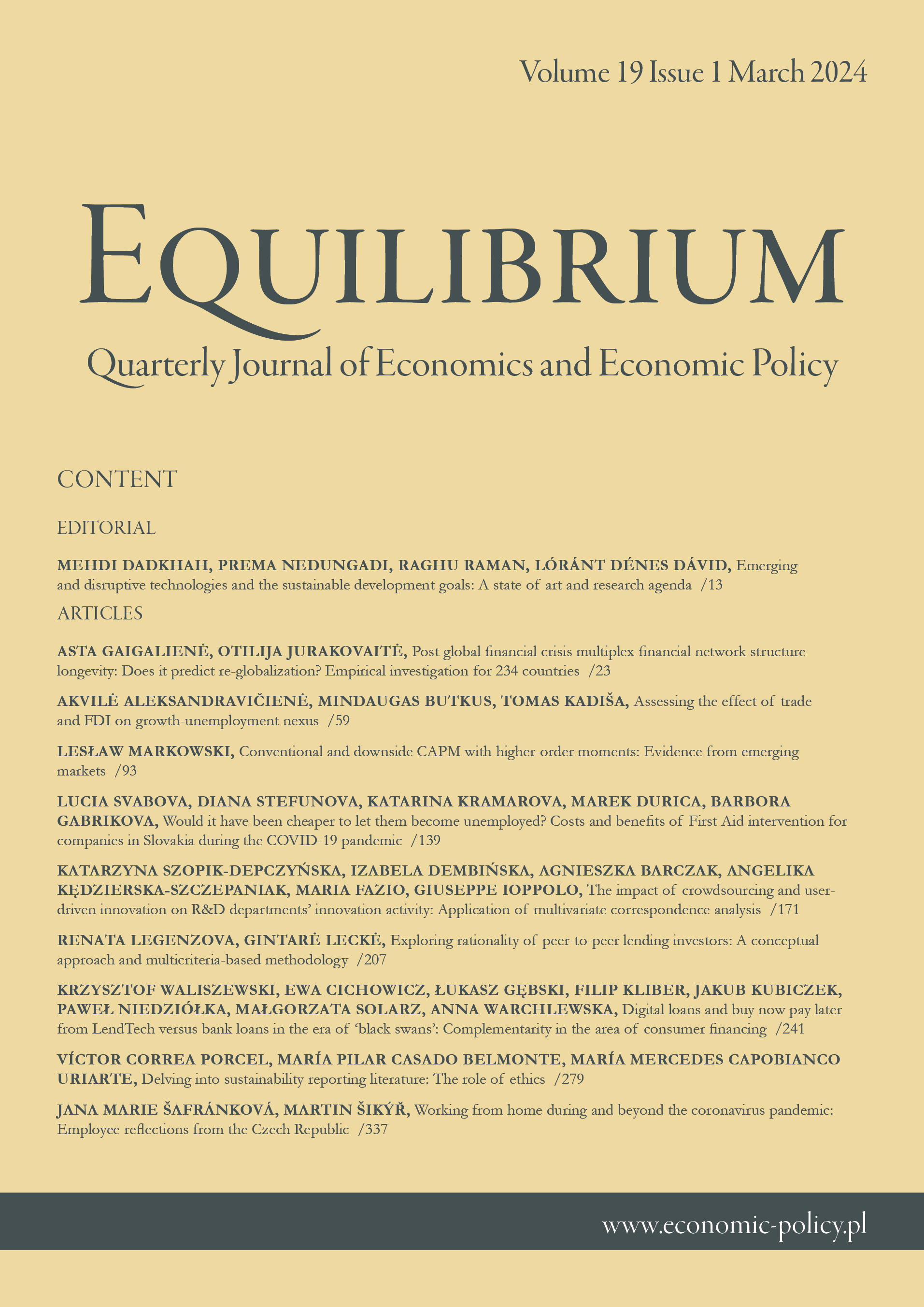中欧和东欧国家与欧元区的实际利率差异
IF 6.2
Q1 ECONOMICS
Equilibrium-Quarterly Journal of Economics and Economic Policy
Pub Date : 2019-12-31
DOI:10.24136/eq.2019.031
引用次数: 5
摘要
研究背景:欧元区与中东欧国家的实际利率差异在过去几年中的变化问题之所以被提出,主要有两个原因。第一个理由与外部金融因素对中东欧经济体及其货币自主性日益重要有关。第二个原因与负利率政策和非常规政策带来的欧洲货币联盟货币状况的前所未有的转变,以及它对中东欧经济体实际利率的影响有关。文章目的:本文旨在探讨欧元区实际利率与10个国家之间的关系:阿尔巴尼亚、保加利亚、捷克共和国、匈牙利、北马其顿、摩尔多瓦、波兰、罗马尼亚、土耳其和乌克兰。该分析涵盖了1999-2018年,包括金融和经济危机前后的时期。方法:利用短期利率和CPI通胀率的月度数据,采用马尔可夫切换回归构建每个国家的事前实际利率序列。一组单位根和平稳性检验,包括标准检验和面板检验,用于检验实际利率平价,也允许利率差异的结构性突破。调查结果和增值:我们提供了关于所有中东欧国家相对于欧元区的实际利率差异的详细证据。我们发现,虽然面板平稳性检验表明了实际利率差异的稳定性,但各国之间存在显著差异,单变量检验的结果往往喜忧参半。然而,至少有一半的经济体在实际利率关系中显示出类似的平稳性模式。与此同时,我们发现捷克共和国、匈牙利和波兰这些高度融入欧洲经济联盟经济的国家的差异随着时间的推移而不稳定。本文章由计算机程序翻译,如有差异,请以英文原文为准。
Real interest rate differentials between Central and Eastern European countries and the euro area
Research background: The question of changes in real interest rates differentials between the Euro Area and the CEE countries in the last years is raised because of two main reasons. The first rationale is related to the growing importance of external financial factors for the CEE economies and their monetary autonomy. The second reason is associated with the unprecedented shift in monetary conditions in the EMU, brought about by negative interest rates policy and unconventional policies, and the way it impacts the real rates in the CEE economies. Purpose of the article: This paper aims at exploring the relationship between real interest rates in the Euro Area and ten countries: Albania, Bulgaria, the Czech Republic, Hungary, North Macedonia, Moldova, Poland, Romania, Turkey, and Ukraine. The analysis covers the years of 1999-2018, including periods before and after the financial and economic crisis. Methods: We employ Markov-switching regression to construct the ex-ante real interest rates series in each country, using monthly data on short-term interest rates and CPI inflation rates. A battery of unit root and stationarity test, both standard and panel ones, is applied to examine the real interest rate parity, also allowing for a structural break in the rate differentials. Findings & Value added: We provide detailed evidence on the real interest rates differentials for all of the CEE countries vis-a-vis the Euro Area. We find that, while panel stationarity tests point to the stability of real rate differentials, there are significant dissimilarities across the countries, and the results of the univariate tests are often mixed. At least half of the economies, however, reveal similar patterns of stationarity in real rates relationships. At the same time, we find differentials for the Czech Republic, Hungary, and Poland, countries highly integrated into the EMU economy, to be unstable over time.
求助全文
通过发布文献求助,成功后即可免费获取论文全文。
去求助
来源期刊
CiteScore
9.20
自引率
3.50%
发文量
28
审稿时长
36 weeks
期刊介绍:
Equilibrium. Quarterly Journal of Economics and Economic Policy is a scientific journal dedicated to economics, which is the result of close cooperation between the Instytut Badań Gospodarczych/Institute of Economic Research (Poland) and Polish Economic Society and leading European universities. The journal constitutes a platform for exchange of views of the scientific community, as well as reflects the current status and trends of world science and economy.
The journal especially welcome empirical articles making use of quantitative methods in: Macroeconomics and Monetary Economics, International Economics, Financial Economics and Banking, Public Economics, Business Economics, Labor and Demographic Economics, Economic Development, and Technological Change, and Growth.
Current most preferable topics and special issues:
The economics of artificial intelligence: business potentials and risks;
Digitalization and entrepreneurship in economics;
Sustainable socio-economic development, environmental and ecological economics;
Transition in the energy market (improving energy efficiency, alternative energy sources, renewable energy, energy security).

 求助内容:
求助内容: 应助结果提醒方式:
应助结果提醒方式:


